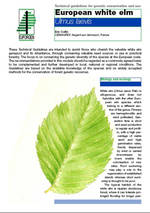Ulmus laevis - Technical guidelines for genetic conservation and use for European white elm
This publication has been translated into the following languages:
French Slovenian
Despite this pathological threat, the in situ conservation of white elm genetic resources is still possible through the establishment of a network of conservation stands. These stands should be selected across the natural distribution range, incorporating ecological variation, comprising at least 50 flowering trees in each. In countries where the distribution of this species in the wild is unknown, a preliminary inventory should be undertaken. Priority should be given to marginal populations and rare floodplain communities in danger of deforestation. Silvicultural management should stimulate and promote natural regeneration. However, planting of the original or local material may be required when regeneration is poor or the number of seed trees is insufficient.
Complementary ex situ conservation measures must be undertaken when no legal habitat protection measure can be taken, when populations are small and fragmented, or when the impact of DED is too strong. In emergency cases, ‘static’ conservation measures, such as clonal archives and cryopreservation of seed lots can be applied. However, ‘dynamic’ ex situ conservation units, such as conservation seed orchards (in artificial conditions) or pseudo in situ conservation units (plantations in original habitat), which brings together diverse material from the same eco-region and enhances genetic exchange, are highly recommended. White elms can easily be propagated by cuttings, and field clonal archives can be maintained as low hedges (1.5 – 2 m), which are less attractive to the vectors of DED.
A European core collection of elm clones has already been established with material from the nine countries participating in the EU RESGEN project. It is important that this collection is complemented with material originating from all the relevant regions of Europe.
Authors: Eric Collin
Journal/Series: EUFORGEN Technical Guidelines for Genetic Conservation and Use
Publication Year: 2003
Publication Format: Folder; PDF
ISBN: 92-9043-603-4
ISBN 13: 978-92-9043-603-4
Language: EN
Pages: 6 p.

